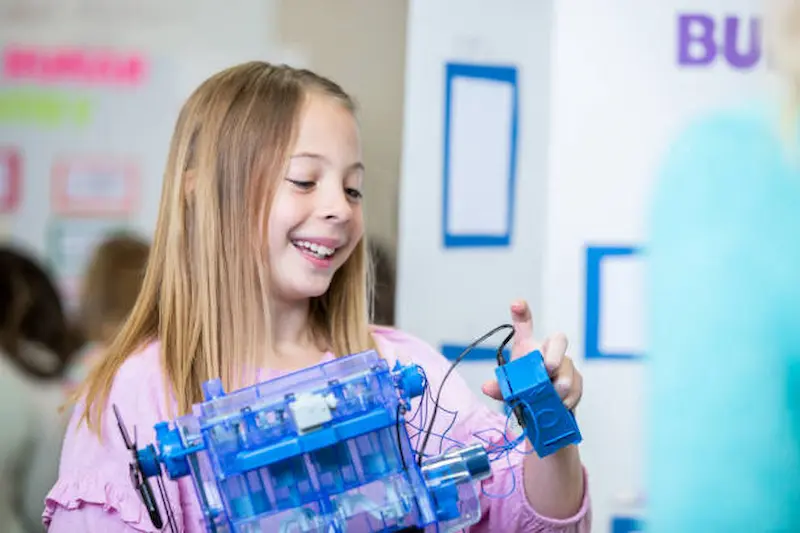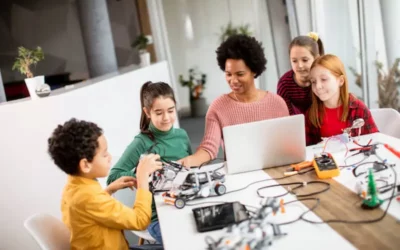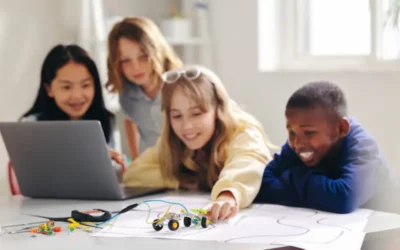A programmable robot for kids is a dynamic educational tool that combines play with learning, introducing children to the world of coding, problem-solving, and technology in a fun and engaging manner. It sparks creativity and fosters critical thinking skills, preparing young learners for a tech-savvy future. Choosing a programmable robot for your child is a forward-thinking decision as it empowers them with essential STEM skills, enhances problem-solving abilities, and cultivates a passion for technology and innovation, preparing them for success in the digital age.
In this blog, we will delve into the fascinating world of programmable robots for kids, exploring their educational significance, benefits, and the exciting ways they inspire young minds to engage with technology, coding, and problem-solving.
Table of contents
Understanding Programmable Robots

A. What Are Programmable Robots?
Programmable robots, often referred to as robotics for kids, are autonomous machines equipped with sensors, actuators, and a programmable control system. These robots can execute tasks based on pre-defined instructions or adapt to their environment through real-time programming.
B. The Educational Benefits of Programming Robots
Programming robots offers significant educational advantages.
- Problem-Solving Skills: It nurtures critical thinking and logical problem-solving. Students must analyze challenges, break them down, and create step-by-step solutions, fostering analytical skills.
- Computational Thinking: Robot programming introduces computational thinking, a vital skill in today’s digital age. It encourages students to approach problems like programmers, emphasizing algorithmic thinking.
- Creativity and Personalization: Students can customize robot behaviors, stimulating creativity and allowing them to express their ideas through coding.
- Collaboration: Robotics projects often entail teamwork, enhancing communication and cooperation skills as students collaborate to achieve common goals.
- World Application: It provides a practical application of theoretical concepts, making learning more engaging and applicable.
C. Safety Considerations
Safety considerations are paramount when working with programmable robots, especially in early childhood learning. Proper training, supervision, and adherence to safety protocols are essential. Users, including children, should be aware of potential hazards, such as moving parts, electrical components, and sharp edges, to ensure a secure learning and working environment.
Key Features

A. Durability and Build Quality
When selecting a product, priorities durability and build quality. Ensure that it can withstand regular use and potential mishandling, especially for children’s devices, to ensure a longer lifespan.
B. Age-Appropriate Features
Consider the intended user’s age and skill level. Look for features and functionalities that align with their developmental stage to provide a safe and engaging experience.
C. Programming Options
Evaluate the device’s programming capabilities. It’s crucial to have room for growth as users advance in their skills, making devices with expandable programming options a wise choice.
D. Compatibility with Devices
Ensure that the product can seamlessly connect with other devices or platforms, enabling a more versatile and interconnected experience for users.
Compatibility enhances the device’s utility and potential for learning and exploration.
Top 10 Programmable Robots
Programmable robots have transformed industries and daily life through their ability to automate tasks, enhance efficiency, and even assist in creative endeavors. Here’s an extended exploration of the top 10 programmable robots, highlighting their valuable contributions:
1. Boston Dynamics’ Spot:
Beyond inspection and security, Spot is aiding in industries like construction, where it navigates challenging terrains, carries payloads, and performs remote inspections. Its adaptability is opening doors for countless applications.
2. UR3e by Universal Robots:
The collaborative nature of UR3e has led to its adoption in healthcare, where it assists surgeons in delicate procedures. Its precise movements and ease of programming make it a valuable asset in the operating room.
3. RoboCup Soccer Robots:
These humanoid robots are not just about soccer. They serve as a testing ground for AI and robotics advancements, with applications in disaster response and search and rescue missions.
4. Baxter by Rethink Robotics:
Baxter is now found in laboratories, helping scientists with repetitive experiments and data collection. Its dexterity and adaptability have elevated it from a manufacturing tool to a research assistant.
5. KUKA KR AGILUS:
Beyond manufacturing, KUKA robots are utilized in healthcare for tasks like surgery and rehabilitation. Their precision and reliability are crucial in life-saving procedures.
6. NASA’s Robonaut 2:
Operating on the International Space Station, Robonaut 2 contributes to experiments and maintenance tasks.
Its humanoid form enables it to handle tools designed for astronauts, reducing their workload.
7. Pepper by Softbank Robotics:
In addition to retail and hospitality, Pepper is used in healthcare settings to provide companionship and emotional support to patients, showcasing the role of robots in improving well-being.
8. DJI RoboMaster S1:
Robotics education is a focus, and the RoboMaster S1 has become a valuable tool in classrooms worldwide, inspiring the next generation of engineers and programmers.
9. Anki Vector:
Vector’s AI capabilities extend to programming and customization, allowing users to create unique interactions and applications, turning it into a versatile personal assistant.
10. iRobot Roomba:
With advancements in AI for kids and smart home integration, Roomba has evolved to not only clean homes but also collect data on indoor air quality and provide valuable insights to homeowners.
These programmable robots are at the forefront of technological innovation, showcasing the remarkable synergy between human creativity and machine capabilities. As they continue to evolve and diversify, they promise to shape industries and our daily lives in unprecedented ways.
How to Choose the Right Robot for Your Kids

Selecting the perfect robot for your child involves careful consideration, especially when exploring options like LEGO robotics for kids. Start by assessing your child’s age and interests. For young kids, choose educational robots that foster creativity and problem-solving, like LEGO Mindstorms or Dash and Dot. Older children may benefit from coding robots like Sphero or Ozobot, which teach programming skills in a fun way. Safety is paramount; ensure the robot is age-appropriate and complies with relevant regulations. Consider expandability and upgradability for long-term engagement. Lastly, consult reviews and seek recommendations from educators or parents to find a robot that aligns with your child’s learning goals and provides a rewarding, educational experience.
Tips for Teaching Kids to Program Robots

A. Starting with Basic Commands
When introducing kids to coding for kids and programming robots, start with basic commands. Teach them to make the robot move forward, turn, and stop. Familiarize them with fundamental programming concepts like loops and conditional statements. This foundation will not only help them understand how robots work but also prepare them to grasp more advanced coding skills as they progress in their coding journey.
B. Encouraging Creativity and Problem Solving
Encourage creativity by challenging kids to think critically and solve problems, nurturing essential critical thinking skills for kids. Have them set goals for the robot and figure out how to achieve them through coding. Let them experiment, make mistakes, and learn from them. This hands-on approach fosters problem-solving skills and innovation.
C. Learning Resources and Tutorials
Utilize online resources and tutorials designed for kids programming, including online games for kids. Websites, apps, and educational platforms offer interactive lessons and games that make learning engaging and enjoyable.
Additionally, consider enrolling your child in coding classes or clubs to enhance their skills and connect with peers who share similar interests. These resources, including online games, provide valuable guidance and support in their programming journey, making the learning experience both fun and educational.
Safety Precautions
When working with robots, safety precautions are paramount. Here are key guidelines to ensure a secure environment:
- Risk Assessment:
Identify potential hazards related to the robot’s operation and workspace. Evaluate the risks associated with moving parts, sharp edges, or electrical components.
- Training:
Ensure everyone interacting with the robot, especially children, receives proper training on its safe operation. Emphasize the importance of following instructions and guidelines.
- Protective Gear:
Depending on the robot’s design and function, provide appropriate safety gear such as gloves, goggles, or helmets to minimize physical risks.
- Emergency Stop:
Implement an easily accessible emergency stop button or mechanism to halt the robot in case of unexpected behavior or danger.
- Maintenance:
Regularly inspect and maintain the robot to prevent wear and tear that could lead to accidents.
By adhering to these safety precautions, you can ensure a secure and enjoyable experience while working with robots.
Inspiring Creativity and Learning

Inspiring creativity and learning is at the heart of STEM (Science, Technology, Engineering, and Mathematics) education, particularly in STEM activities for elementary students, where robotics plays a pivotal role. It fosters creativity by encouraging children to design, build, and program their robots, allowing them to explore real-world applications of science and technology concepts. This hands-on approach not only sparks innovation but also hones problem-solving skills and critical thinking abilities. By integrating robotics into STEM education, we equip the next generation, including elementary students, with the tools and mindset they need to tackle complex challenges and drive future advancements in science and technology. Kids learn programming online through specialized courses and interactive platforms that prepare them for these challenges.
Conclusion
A programmable robot for kids is an educational tool that introduces coding and problem-solving concepts through interactive and enjoyable activities, making learning both engaging and fun. These robots provide a hands-on way for children to learn programming and problem-solving skills in a fun and engaging manner. They encourage creativity as kids design and code their robot’s actions, fostering a sense of accomplishment. Additionally, programmable robots help enhance critical thinking and teamwork as children often collaborate to achieve various tasks and challenges, making them valuable educational tools for young learners.
To get your hands on more educational and free resources on coding for kids, robotics for kids, financial education for kids, etc., do check out the BrightCHAMPS Page now!
To get your hands on more such educational and free resources on coding, robotics, game development, etc., do check out the Brightchamps Blog Page now!
Frequently Asked Questions ( FAQs )
A1. The suitability of programmable robots varies, but many are designed for ages 6 and up.
Q2. Are programmable robots safe for kids?
A2. Programmable robots can be safe for kids when age-appropriate models and proper supervision are ensured.
Q3. How can I choose the right robot for my child’s age?
A3. Choose a robot based on your child’s age, opting for simpler models for younger kids and more complex ones for older children.
Q4. What programming languages are used with these robots?
A4. Programming languages like Scratch, Blockly, and Python are commonly used with these robots.
Q5. Are there any robot maintenance tips I should know?
A5. Regularly inspect and clean the robot’s components, check for software updates, and store it properly to extend its lifespan.


 We are an army of educators and passionate learners from BrightChamps family, committed to providing free learning resources to kids, parents & students.
We are an army of educators and passionate learners from BrightChamps family, committed to providing free learning resources to kids, parents & students.













